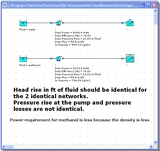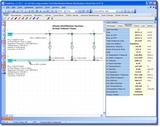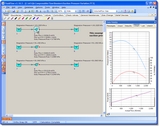 |
|||||||||||||||
|
|
||||||||||||||
| |||||||||||||||
|
Fluid Flow Calculations Liquid Gas Two-Phase Non-Newtonian Heat Transfer Dynamic Analysis & Scripting Example Videos Navisworks Data Extraction Surveyor Plugin Doculink+ Plugin Plant Modelling & Design AutoCAD Plant 3D AutoCAD P&ID Excelat CAD Information and Advice Arrange a Presentation Careers Contact Us |
Piping Systems FluidFlow3 - Design and Simulation Software
| ||||||||||||||
 Same pump, same flow, different fluids Same pump, same flow, different fluids |
 Heat transfer and mixing in a recycle line Heat transfer and mixing in a recycle line |
 This example is designed to show that a pump operating in any system will always deliver the same head (m Fluid), irrespective of the fluid pumped. The power requirement will change as will system friction loss depending on the fluid physical properties. The pdf report shows the flowsheet and tabular results (user definable)
This example is designed to show that a pump operating in any system will always deliver the same head (m Fluid), irrespective of the fluid pumped. The power requirement will change as will system friction loss depending on the fluid physical properties. The pdf report shows the flowsheet and tabular results (user definable) |
 This network contains a pumped recycle loop with a second fluid (acetone at a higher temperature) which is added in the recycle line. The pdf report contains the flowsheet only, but this has been adjusted to show all important results. In this case the complete design and operation can be communicated on one sheet of paper.
This network contains a pumped recycle loop with a second fluid (acetone at a higher temperature) which is added in the recycle line. The pdf report contains the flowsheet only, but this has been adjusted to show all important results. In this case the complete design and operation can be communicated on one sheet of paper. |
 Steam distribution through a branched network Steam distribution through a branched network |
 Fan operating performance Fan operating performance |
|
 This example shows how steam flow is distributed through 4 laterals each containing a different resistance. The pdf report shows the flowsheet and tabular results (user definable). For steam flow we have elected to show the actual volumetric flow. Note how this increases as the steam pressure reduces and how density and temperature reduce. FluidFlow works with real gases, the calculations do not make any simplifying assumptions such as ideal gas, adiabatic conditions etc.
This example shows how steam flow is distributed through 4 laterals each containing a different resistance. The pdf report shows the flowsheet and tabular results (user definable). For steam flow we have elected to show the actual volumetric flow. Note how this increases as the steam pressure reduces and how density and temperature reduce. FluidFlow works with real gases, the calculations do not make any simplifying assumptions such as ideal gas, adiabatic conditions etc. |
 In this example we consider the performance of a fan at different suction pressures. The delivery systems are identical, notice how actual volume flow and presure rise changes as a function of suction pressure. The pdf report shows the flowsheet and tabular results.
In this example we consider the performance of a fan at different suction pressures. The delivery systems are identical, notice how actual volume flow and presure rise changes as a function of suction pressure. The pdf report shows the flowsheet and tabular results. |
|
Follow this link to view a series of Example FluidFlow3 Videos. Adobe Flash Player 6.0 or later required
